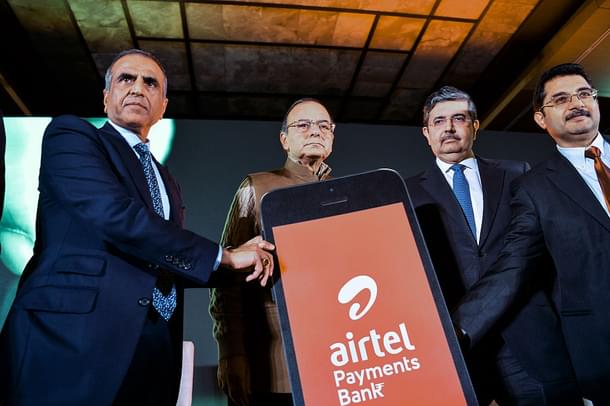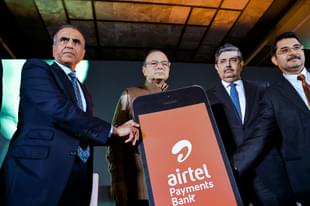Economy
Payment Banks – Struggling To Find Feet While Digital Payments Vault
Aashish Chandorkar
Jul 27, 2019, 02:31 PM | Updated 02:31 PM IST
Save & read from anywhere!
Bookmark stories for easy access on any device or the Swarajya app.


In September 2013, the Reserve Bank of India (RBI) had set up the Committee on Comprehensive Financial Services for Small Businesses and Low Income Households headed by Nachiket Mor, then a board member of the RBI and a senior banker. One of the recommendations of the committee, presented in a comprehensive report in January 2014, was to set up Payment Banks (PBs).
Payment Banks were supposed to provide services like Pre-Paid Instruments (PPIs) – accounts where customers deposited money and used it for specific small payments – utilities, shopping, business bills – and so on. PPIs or wallets were anyway catching on around this time, and the Mor Committee sought to formalise this product via entry of established businesses with a minimum capital requirement of Rs. 50 crore.
The main difference between the PPI products and the payment banks was to be the PBs paying interest to their customers. However, they were not allowed to lend and could only accept deposits up to Rs. 1 lakh from a customer. They were to invest the account balances in specific government securities only.
On top of this very narrow business model, with restrictions on both asset and liability side, the PBs were to maintain a capital to risk weighted assets ratio of 15 per cent. Although the PBs faced no credit risk and a very low market risk given that their investible corpus was to be fully deployed in government securities, the business model meant that these banks faced operational and liquidity risks.
Despite these restrictions, the RBI received 41 applications of PBs when it opened the window for this business model. From telecom companies to Information Technology players, and from India Post to new market entrants looking for a pie of digital payments, a host of names came forward to launch their PBs. Eventually, in August 2015, the RBI granted 11 PB licenses to Aditya Birla Nuvo (joint venture with Idea Cellular), Airtel, Cholamandalam, Dilip Sanghvi of Sun Pharmaceuticals, India Post, Fino, NSDL, Reliance Industries, Paytm, Tech Mahindra, and Vodafone m-pesa.
Launching the Unified Payments Interface (UPI) in April 2016, Raghuram Rajan, then Governor of the RBI, had said that the RBI was betting on the PBs to push the existing banking system to become more innovative. He also explained how PB licenses were an attempt by the regulator to not come in the way of innovative players like Paytm.
Unfortunately, around the same time, some of the players had started to find the business model tiresome with long gestation, difficult road to profitability given the high customer acquisition costs, and very little margin to work with. In March 2016, Cholamandalam surrendered its license followed by Dilip Sanghvi of Sun Pharma in May 2016. Tech Mahindra followed suit soon after.
Airtel became the first licence holder to actually launch a service in January 2017. Relying on its vast network of telecom customers, Airtel bet on lowering customer acquisition costs and marketing and distribution muscle to overpower the high cost of entry. Other players joined in as the PBs gradually took off. However, just 30 months later, the situation is grim. Vodafone m-pesa announced it was shutting shop in July 2019. Aditya Birla Nuvo also decided to end its operations by October 2019. Only three PBs — Airtel, Fino, and Paytm are fully operational, while India Post, Jio, and NSDL are yet to scale up.
Until December 2018, all PBs in total had garnered just about Rs. 780 crore in deposits — a fraction of the Indian banking system. While almost 70 per cent of bank accounts in India have less than Rs. 1 lakh in deposits, these deposits only form about 9 per cent of the total bank deposits by value. These banks also found it tough to incentivise customers to open yet another account only for payments, when the same service could be availed through a variety of other means. With the Supreme Court disallowing the use of Aadhar for authentication and new bank account opening, the problem of onboarding new customers became even more acute.
With no margins in the business except for transaction charges and any allied third party services, the PBs found the going tough to open new accounts without the aid of technology. As the number of digital payment options grew and got integrated with offline merchant payments, the use cases for PBs continued to reduce while customer growth was flat-lined. Remittances, which was considered a key use case for PBs, also could not fire the small-ticket size market.
The biggest operational issue for the PBs has been running the business with a fixed spread. On one side, they are required to pay the customers 4 per cent interest on their deposits with the bank. On the other side, the PBs can only park their deposits in government securities, which do not earn more than 6.5-7 per cent on 10-year G-Sec.
The PBs will in effect be deploying their deposits in lower maturity government securities, given this is a high-flow business. With few sources of income from the business itself, and a spread of just over 2 per cent to play with, the only way PBs could make more revenue was to garner more deposits. But this required heavy marketing spend and dealing with costs of customer acquisition, all to be fitted in that small spread.
On top of this problem, PBs were also saddled with other restrictions. They were mandated to open 25 per cent of their physical touchpoints in rural areas. They could not accept deposits from non-resident Indians. PBs were also not allowed to open subsidiaries in other businesses, given the licenses were open to anyone satisfying the minimum capital requirements.
The RBI didn’t want industrial houses to take over or challenge the banking sector through a PB backdoor and hence they were barred from venturing into other areas like non-banking financial companies.
Airtel and Paytm are leveraging their vast existing customer networks to expand the PB operations. Both have the options to cross-sell other services, thus generating new sources of income. Presumably, Jio and to a lesser extent NSDL can do the same. India Post has grappled with delays to its technology infrastructure upgrade and to find a place in the Indian banking system, an endeavour it has taken up a couple of decades too late. Fino is the only pureplay PB, working within the constraints to run its operations. Only Paytm PB declared a profit as per the most recent financial data available.
Is there light at the end of the tunnel? The Parliament recently allowed Aadhar-based KYC authentication on a voluntary basis through a legislative measure. This is absolutely essential for the PBs to survive. They also need to find new sources of income, mainly acting as third-party agents, to generate fee-based income. The PBs also need to crack the code on how to attract customer deposits. Aditya Birla Nuvo could garner just Rs. 5.82 crore in deposits when it announced shutting down of operations!
The Nachiket Mor Committee had come up with six vision statements addressing different aspects of financial inclusion. Ironically, the only vision that’s reached near-conclusion is universal banking access, a result of government’s push on Jan Dhan accounts since August 2014.
PBs were the outcome of the other vision statement on universal access to payment services and deposit products at reasonable charges. Unfortunately, caught in a maze of design challenges imposed by the RBI, this objective is still a work-in-progress.
The digital payments landscape in India has changed dramatically since 2016. PBs continue to struggle to find relevance in a payment ecosystem they were supposed to drive and develop. Full of new technology-savvy entrants, low cost of using industry-wide infrastructure such as the UPI, and scheduled commercial banks also jumping in the fray, India’s payments landscape is cut-throat.
Should a customer use a new account just for payments if she gets the same services from an existing bank? Neither the PBs nor the RBI seem to have a good answer right now.
Aashish Chandorkar is Counsellor at the Permanent Mission of India to the World Trade Organization in Geneva. He took up this role in September 2021. He writes on public policy in his personal capacity.





